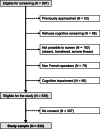Life worth living: cross-sectional study on the prevalence and determinants of the wish to die in elderly patients hospitalized in an internal medicine ward
- PMID: 32928145
- PMCID: PMC7491164
- DOI: 10.1186/s12877-020-01762-x
Life worth living: cross-sectional study on the prevalence and determinants of the wish to die in elderly patients hospitalized in an internal medicine ward
Abstract
Background: Elderly people frequently express the wish to die: this ranges from a simple wish for a natural death to a more explicit request for death. The frequency of the wish to die and its associated factors have not been assessed in acute hospitalization settings. This study aimed to investigate the prevalence and determinants of the wish to die in elderly (≥65 years) patients hospitalized in an internal medicine ward.
Methods: This cross-sectional study was conducted between 1 May, 2018, and 30 April, 2019, in an acute care internal medicine ward in a Swiss university hospital. Participants were a consecutive sample of 232 patients (44.8% women, 79.3 ± 8.1 years) with no cognitive impairment. Wish to die was assessed using the Schedule of Attitudes toward Hastened Death-senior and the Categories of Attitudes toward Death Occurrence scales.
Results: Prevalence of the wish to die was 8.6% (95% confidence interval [CI]: 5.3-13.0). Bivariate analysis showed that patients expressing the wish to die were older (P = .014), had a lower quality of life (P < .001), and showed more depressive symptoms (P = .044). Multivariable analysis showed that increased age was positively (odds ratio [OR] for a 5-year increase: 1.43, 95% CI 0.99-2.04, P = .048) and quality of life negatively (OR: 0.54, 95% CI 0.39-0.75, P < 0.001) associated with the likelihood of wishing to die. Participants did not experience stress during the interview.
Conclusions: Prevalence of the wish to die among elderly patients admitted to an acute hospital setting is low, but highly relevant for clinical practice. Older age increases and better quality of life decreases the likelihood of wishing to die. Discussion of death appears to be well tolerated by patients.
Keywords: Acute care; Internal medicine; Quality of life; Switzerland; Wish to die.
Conflict of interest statement
The authors report no conflict of interest.
Figures
Similar articles
-
Wish to Die in Older Patients: Development and Validation of Two Assessment Instruments.J Am Geriatr Soc. 2020 Jun;68(6):1202-1209. doi: 10.1111/jgs.16392. Epub 2020 Feb 29. J Am Geriatr Soc. 2020. PMID: 32112569
-
Factors associated with the wish to die in elderly people.Age Ageing. 1995 Sep;24(5):389-92. doi: 10.1093/ageing/24.5.389. Age Ageing. 1995. PMID: 8669340
-
Chronic medical conditions and wishes to die among older primary care patients.Int J Psychiatry Med. 2006;36(2):183-98. doi: 10.2190/3QXD-UR0H-K8FH-2CU8. Int J Psychiatry Med. 2006. PMID: 17154148 Free PMC article.
-
Are religiousness and death attitudes associated with the wish to die in older people?Int Psychogeriatr. 2016 Mar;28(3):397-404. doi: 10.1017/S1041610215001192. Epub 2015 Aug 24. Int Psychogeriatr. 2016. PMID: 26300555
-
Experiences and motivations underlying wishes to die in older people who are tired of living: a research area in its infancy.Omega (Westport). 2014;69(2):191-216. doi: 10.2190/OM.69.2.f. Omega (Westport). 2014. PMID: 25223313 Review.
References
-
- Rehmann-Sutter C, Gudat H, Ohnsorge K. The patient's wish to die : research, ethics, and palliative care. Oxford: Oxford University Press; 2015.
-
- Rubli Truchard E, Monod S, Jox R. The wish to die in elderly nursing homes residents [abstract] J Am Geriatr Soc. 2018;66(Suppl 2):S113.
Publication types
MeSH terms
LinkOut - more resources
Full Text Sources
Medical
Miscellaneous



